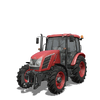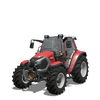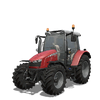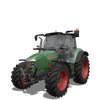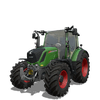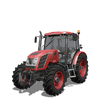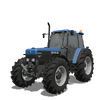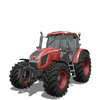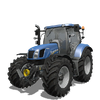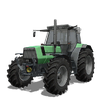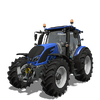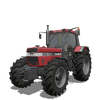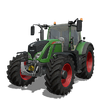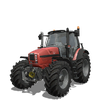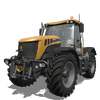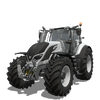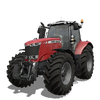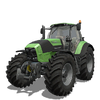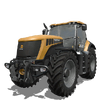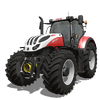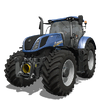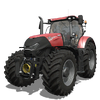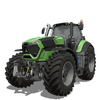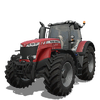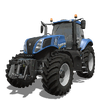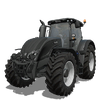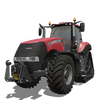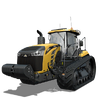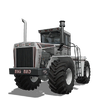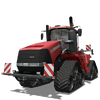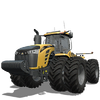Tractors/Farming Simulator 17
- Main article: Tractors
Tractors are vehicles capable of towing and operating almost any type of equipment in the game. A single tractor can perform nearly any job on your farm given the correct equipment, with very few exceptions. Although tractors are typically not the best vehicles for most jobs (e.g. forestry, towing tippers, stacking pallets), a good tractor can fill in for any expensive machine you can't afford yet, and often costs much less to buy.
Farming Simulator 17 offers 38 different models of tractors by default. There are many differences between these models, but the most important differences tend to be cost and horsepower. A stronger tractor typically costs more, but will have an easier time working with heavier equipment. Additionally, many tractors have special upgrades that can make them more useful than other tractors.
List of Tractors
Below is a list of all tractor models in Farming Simulator 17. For a table including engine-upgraded models and a comparison of cost to HP, see Tractor Cost Efficiency.
| Name | Price | Maintenance cost per day |
Power
(hp) |
Max Speed | Fuel Capacity |
|---|---|---|---|---|---|
| Zetor Major 80 | 57,000 | 110 | 75 | 33 km/h
20 mph |
83 L
22 gal |
| Hürlimann H 488 | 45,000 | 210 | 88 | 42 km/h
26 mph |
100 L
26.4 gal |
| Steyr Multi | 82,000 | 115 | 99 / 114 | 43 km/h
26 mph |
150 L
39.6 gal |
| New Holland T5 | 83,000 | 110 | 99 / 117 | 43 km/h
26 mph |
165 L
43.6 gal |
| Lindner Lintrac 90 | 84,000 | 115 | 102 | 43 km/h
26 mph |
80 L
21.1 gal |
| Massey Ferguson MF 5600 | 87,000 | 120 | 105 / 130 | 43 km/h
26 mph |
160 L
42.3 gal |
| Hürlimann XM T4i | 91,000 | 130 | 110 / 127 | 43 km/h
26 mph |
160 L
42.3 gal |
| Fendt 300 Vario | 111,000 | 100 | 110 / 138 | 43 km/h
26 mph |
210 L
55.5 gal |
| Zetor Proxima Power 120 | 89,000 | 170 | 117 | 43 km/h
26 mph |
180 L
47.6 gal |
| New Holland 8340 | 85,000 | 200 | 125 | 43 km/h
26 mph |
218 L
57.6 gal |
| Zetor Forterra HD | 99,000 | 180 | 127 / 147 | 43 km/h
26 mph |
220 L
58.1 gal |
| New Holland T6 | 117,000 | 170 | 143 / 163 | 53 km/h
32 mph |
175 L
46.2 gal |
| Deutz Fahr AgroStar 6.61 | 97,000 | 250 | 143 | 43 km/h
26 mph |
290 L
79.6 gal |
| Valtra N Series | 119,000 | 170 | 145 / 165 / 185 | 53 km/h
32 mph |
315 L
83.2 gal |
| Case IH 1455 XL | 102,000 | 260 | 145 | 43 km/h
26 mph |
240 L
63.4 gal |
| Fendt 700 Vario | 164,000 | 160 | 165 / 200 / 240 | 53 km/h
32 mph |
400 L
105.7 gal |
| Same Fortis | 138,000 | 190 | 166 / 193 | 53 km/h
32 mph |
280 L
74 gal |
| JCB Fastrac 3000 Xtra | 165,000 | 250 | 195 / 230 | 72 km/h
45 mph |
400 L
105.7 gal |
| Valtra T Series | 170,000 | 260 | 210 / 250 | 52 km/h
32 mph |
380 L
100.4 gal |
| Massey Ferguson MF 7700 | 172,000 | 250 | 210 / 240 / 280 | 53 km/h
32 mph |
430 L
113.6 gal |
| Deutz Fahr Series 7 | 185,000 | 270 | 224 / 245 / 263 | 63 km/h
39 mph |
435 L
115 gal |
| Lamborghini Mach VRT | 189,000 | 270 | 224 / 245 / 263 | 63 km/h
39 mph |
400 L
105.7 gal |
| Case IH Puma CVX | 192,000 | 190 | 225 / 245 / 263 | 53 km/h
32 mph |
330 L
103 gal |
| JCB Fastrac 8000 | 225,000 | 370 | 280 / 310 | 72 km/h
45 mph |
550 L
145.3 gal |
| Steyr Terrus CVT | 226,000 | 360 | 288 / 313 | 53 km/h
32 mph |
630 L
166.4 gal |
| New Holland T7 Heavy Duty | 231,000 | 345 | 288 / 313 | 53 km/h
32 mph |
630 L
166.4 gal |
| Case IH Optum CVX | 234,000 | 340 | 288 / 313 | 53 km/h
32 mph |
630 L
166.4 gal |
| Deutz Fahr Series 9 | 245,000 | 350 | 295 / 312 / 336 | 63 km/h
39 mph |
600 L
158.5 gal |
| Fendt 900 Vario | 272,000 | 320 | 300 / 360 / 390 | 63 km/h
39 mph |
600 L
158.5 gal |
| Massey Ferguson MF 8700 | 249,000 | 360 | 300 / 350 / 400 | 52 km/h
32 mph |
630 L
166.4 gal |
| New Holland T8 | 262,000 | 390 | 320 / 381 / 435 | 53 km/h
32 mph |
609 L
160.8 gal |
| Valtra S Series | 289,000 | 440 | 350 / 400 | 52 km/h
32 mph |
610 L
161.1 gal |
| Challenger MT700E | 314,000 | 470 | 384 / 411 / 438 | 43 km/h
26 mph |
659 L
174.1 gal |
| Case IH Magnum CVX / 340 | 352,000 | 480 | 409 / 435 | 53 km/h
32 mph |
678 L
179.1 gal |
| New Holland T9 | 385,000 | 560 | 469 / 557 | 43 km/h
26 mph |
1162 L
307 gal |
| Challenger MT800E | 396,000 | 500 | 469 / 592 / 646 | 43 km/h
26 mph |
1002 L
264.7 gal |
| Big Bud 450 | 225,000 | 620 | 550 | 30 km/h | 2082 L |
| Big Bud 747 | 405,000 | 780 | 1100 | 30 km/h | 3785 L |
| Case IH Quadtrac | 412,000 | 630 | 525 / 613 / 692 | 43 km/h
26 mph |
1880 L
496.6 gal |
| Challenger MT900E | 425,000 | 640 | 536 / 591 / 646 | 43 km/h
26 mph |
1514 L
400 gal |
Tractor Categories
Tractors differ from one another mostly by Horsepower. A tractor's horsepower determines how much weight it can pull comfortably, and therefore what Implements it can operate, and what Trailers it can tow. Therefore, tractors can be split into rough groups to show which tractors are suitable for which jobs.
Small
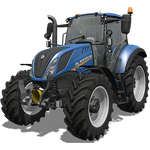
Horsepower range: 75 - 140 HP
Small tractors are the cheapest and weakest of all tractors. Their low cost is pretty much their only advantage over other tractor categories. Most scenarios give the player at least one Small Tractor for free, to start with, and more can easily be bought early on.
Small tractors are not really suitable for fieldwork, since they can only operate the smallest Implements. Almost every type of Implement (such as Sowing Machines, Cultivators, Mowers, etc.) includes at least one model that's small enough to be carried and operated by a Small Tractor. These small Implements are really quite small, and it takes a lot of time to process even a single small field.
Small tractors are technically capable of towing Tippers and Loading Wagons - but again, only the smallest models. Even the smallest tipper, when fully loaded, can pose a problem for a Small Tractor. Even a Car should be able to out-perform a Small Tractor when towing.
Most Small tractors can be fitted a Front Loading Arm, allowing them to move cargo and Pallets. With an arm installed, a Small Tractor is a relatively decent choice for Animal Husbandry work. Nonetheless, it's important to remember that a Small Tractor is a very light vehicle - they tend to tip over when lifting heavy cargo, or when making sharp turns while carrying such cargo. Driving carefully, and attaching a Weight to the back of the Tractor, can help mitigate this problem.
Overall, Small Tractors gradually become obsolete as you get the money to buy larger Tractor models.
Medium
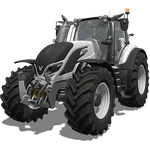
Horsepower range: 140 - 280 HP
Medium Tractors are a significant step up from Small Tractors in many different ways, mostly thanks to their powerful engine and increased stability.
The engine of a Medium Tractor is powerful enough to operate medium field Implements, or a couple of small Implements simultaneously (e.g. two Mowers). When using these tools, a Medium tractor can complete its fieldwork a lot faster than a Small tractor would.
Medium Tractors are the best vehicles for operating a Front Loading Arm. They are much heavier than Small Tractors, and this weight gives them much-needed stability when front-loading heavy cargo; they don't tip over as easily. Some Medium Tractors can be further upgraded with Wide Tires or even Twin Wheels, increasing stability even more. This Stability when Front-Loading, coupled with a Tractor's innate ability to operate machinery and perform a wide variety of different jobs, makes Medium Front-Loading Tractors some of the best Loaders for Animal Husbandry.
Finally, Medium Tractors are also powerful enough to tow small-model Tippers and Loading Wagons with ease, even when they are full of cargo. Medium Tractors are not very speedy, but if you need towing and can't get a faster (or stronger) vehicle to do it, a Medium Tractor might be able to fill in temporarily.
Large
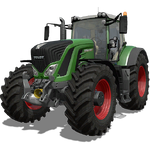
Horsepower range: 280 - 450 HP
Large tractors are designed for field work, and have the necessary horsepower to operate any field machinery comfortably - with the exception of super-heavy Plows. They can tow and operate all Cultivators, Sowing Machines, and pretty much any other equipment you can buy. These larger implements make fieldwork - even on large fields - go smoothly and quickly. There are no vehicles more suitable for field work than Large tractors.
Large tractors are also very good at towing Tippers and Loading Wagons (except the really massive ones), even when they are fully loaded. Large tractors tend to be relatively fast, and can move both tippers and machinery from place to place rather quickly. Because many implements cannot be attached to a Truck, Large tractors will often be used to move such implements from field to field or from shop to farm. The largest of the Large tractors are even capable of towing massive Tippers to your silo or selling point, although they are not as good as a Truck for this job.
Finally, note that Large Tractors do not have an attachment point for a Front Loading Arm, and therefore cannot do any lifting. If you need a powerful vehicle for this (e.g. for Silage work), consider buying a Wheel Loader or Telehandler instead.
Super-Large
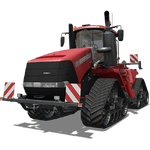
Horsepower range: 450+ HP
Super-Large tractors are incredibly powerful machines that rival (or even surpass) Trucks in sheer horsepower - but their cost and maintenance are respectively high. These gigantic vehicles can perform field work with any machinery with ease, but their primary purpose is to operate super-heavy Plows, which smaller tractors may struggle with.
Furthermore, the strongest of the Super-Large tractors are actually powerful enough to pull a massive Tipper when it is fully loaded, even uphill. On some maps, they may perform better than the strongest Truck when pulling such tippers.
Super-Large tractors typically lack a front-side Three-point hitch, and their only Drawbar (Bolt) attachment is typically at the front of the tractor. This makes them useless at pulling certain types of trailers. However by the time you can afford a Super-Large tractor, you can probably buy some other vehicle to pull those trailers.
Upgrades
Most Tractors in Farming Simulator 17 can receive upgrades either at purchase-time, at the local Vehicle Sale Point, or at a player-owned Workshop. These upgrades range from the extremely-useful (engine upgrades) to the completely cosmetic (paint jobs). All tractors feature at least one customization option, with the average being about 3 options.
Engine Upgrades
The most important customization option for tractors is an Engine Upgrade, which replaces the tractor's default engine with a stronger one. This increases the horsepower output of the engine, but also the purchase price and the maintenance cost. A few engine upgrades also increase the tractor's Fuel Capacity.
Once upgraded, the tractor will be able to work more comfortably with heavier pieces of equipment, and may even be able to operate equipment that it could not without the upgrade.
The availability of engine upgrades means that you can buy a cheaper tractor at first, and then when more money is available you can upgrade that tractor to get a little more power out of it. This is often also much cheaper than buying a stronger tractor.
Some tractors - particularly larger ones - offer two engine upgrades. This allows you to upgrade your tractor a second time when the money becomes available, boosting its strength even further.
For a full list of tractors including all upgraded-engine models, see Tractor Cost Efficiency.
Wheel Upgrades
The majority of tractors in the game can have their tires or wheels replaced with different versions. Available options include narrower tires, wider tires, or even additional wheels. Some tractors can even be fitted with a Crawler Track.
In general, installing wider tires will make the tractor more stable when making turns - reducing the chance of flipping over. Twin Wheels reduce the chance even more. This is important for tractors with Front Loading Arm attachments (which can flip over easily when lifting heavy cargo), or for tractors intended to quickly move equipment from one field to another.
Installing narrower wheels is not advisable when playing the base game. However, when using Giants' official Crop Destruction mod, narrow tires are exceptionally important for any tractor that is going to Fertilize a field while it's growing. This is because narrow tires will destroy much less crop as they drive over it to fertilize the field. On the other hand, narrow tires make the tractor much more prone to flipping, so care should be taken when driving them at any speed.
It's important to remember that Twin Wheels and Triple Wheels, while making the tractor a lot more stable, also make it a lot wider. This can be a problem when maneuvering the tractor in tight spaces, and can prevent it from entering certain places (such as the Barn).
Finally, note that while Crawler Track upgrades are very cool-looking, they do very little to help your tractor's performance - especially considering the extremely high costs involved (usu. $20,000).
Front Loader Attacher
- Main article: Front Loading Arms (Farming Simulator 17)
Most Small tractors and all Medium tractors in the base game can be fitted with a Front Loader Attacher. This upgrade is required in order to attach a Front Loading Arm to the tractor. Without this upgrade, the arm will not attach.
Once a Front Loader arm has been attached, you can then attach a Loading Tool at the end of the arm. There are many different tools for different tasks, such as lifting Pallets, shoveling Piles, lifting Logs, and arranging Bales. Some tools are suitable for multiple different jobs.
Remember that a tractor's weight determines how likely it is to flip over when lifting heavy cargo - especially when making sharp turns when the cargo is lifted high above the tractor. This is why Medium tractors are generally better for Front Loading jobs than small tractors. If your tractor is not heavy enough, consider attaching a Weight at the back, or adding the Wheel Weights upgrade.
Main / Rim Color
Several tractors can be repainted in a variety of colors. This is a completely cosmetic upgrade that does not affect the tractor's performance.
Color upgrades come in two types: Main Color upgrades will paint the body of the tractor. Rim Color upgrades will only paint the wheel rims (the metal plate at the center of the tires). A tractor model may offer one upgrade or the other, or both, or neither.
The choice of colors is often limited - just one optional color to replace the default color. A few tractors (particularly those manufactured by Valtra) can be repainted in any color from the game's palette.
Note that Main Color upgrades are more expensive than Rim Color upgrades.
Design Upgrade
A few tractors offer the option to buy a "special edition" version of a tractor. This is usually very expensive, but the end result is different from one tractor model to the next. Typically, however, these upgrades do not change the tractor's functionality - they are purely cosmetic.
DLC-Released Tractors
Big Bud 450 - Big Bud DLC
Big Bud 747 - Big Bud DLC
Massey Ferguson MF 4709 - Platinum Add-on
Stara ST MAX 105 - Platinum Add-on
Stara ST MAX 150/180 - Platinum Add-on
| Tractors in Farming Simulator 17 | |
|---|---|
| Small | |
| Medium | Case IH 1455 XL - Case IH Puma CVX - Deutz Fahr AgroStar 6.61 - Deutz Fahr Series 7 - Fendt 700 Vario - JCB Fastrac 3000 Xtra - Lamborghini Mach VRT - Massey Ferguson MF 7700 - New Holland T6 - Same Fortis - Stara ST MAX 150/180 (DLC) - Valtra N Series - Valtra T Series |
| Large | |
| Heavy steiger/quadtrac/rowtrac tractors | Big Bud 450 (DLC) - Big Bud 747 (DLC) - Challenger MT700E - Challenger MT800E - Challenger MT900E - Case IH Magnum CVX - Case IH Quadtrac - New Holland T9 |

